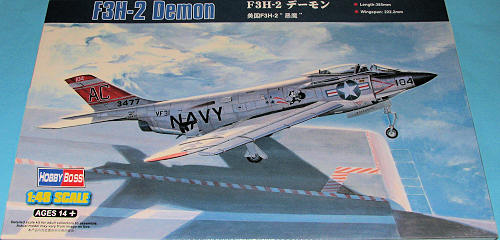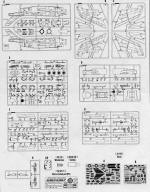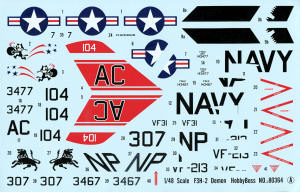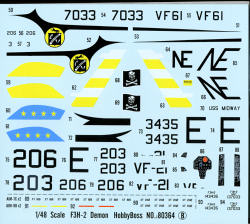
HobbyBoss 1/48 F3H-2 Demon
| KIT #: | 80364 |
| PRICE: | $59.99 SRP |
| DECALS: | Four options |
| REVIEWER: | Scott Van Aken |
| NOTES: | New tool kit |

| HISTORY |
The McDonnell F3H Demon was a US Navy carrier-based jet fighter aircraft. The successor to the F2H Banshee, after initial problems, it served from 1956 until 1964. Development work began in 1949, the aircraft was designed around only a single Westinghouse Electric Corporation J-40 engine, which was to have over 11,000 lb of thrust - three times that of the engines in the Banshee. It was the first swept-wing design produced by McDonnell and among the first US aircraft to have missile armament.
The prototype first flew in 1951 and first test flights of the operational design were in January 1953. The engine was a major disappointment, producing only half of the expected power it was temperamental and unreliable, of 35 F3H-1 aircraft that were flown with the J-40 engine eight were involved in major accidents. The J-40 engined aircraft were grounded and a new engine was sought. (In fact, brand new J-40 powered Demons were barged or trucked directly to training schools and never flown, starting an investigation into fraud by members of Congress. Things never change.) The best alternative was destined for the F-100 Super Sabre and subsequent F3Hs were fitted with the Allison J-71 engine (also used in the B-66) and designated the F3H-2. While more reliable this new engine had to be 'shoe-horned' into the airframe and with less power than needed did little for the aircraft's performance.
The first Demon with a J-71 flew in October 1954. Another problem was with the ejector seats, initial versions could fail to operate and had to be replaced with Martin Baker models. Despite the problems in 1956 the Navy ordered 239 F3H-2s and the first were deployed in March 1956. 522 Demons of all versions were built up to the end of production in November 1959. It was the Navy's first all-weather interceptor with radar and the Raytheon Sparrow or Sidewinder AAM and remained the Navy's front-line fighter until 1962 when it was succeeded by the F-4 Phantom II. Although developed during the Korean War it did not see action, although it flew over Lebanon and Quemoy in 1958. With the more powerful engine, the aircraft was a delight to fly, though still rather short-legged.
| THE KIT |
 Undoubtedly spurred on by the huge success of the short runGrand Phoenix kit, Hobby Boss now has produced this very nicely done mainstream injected plastic kit of the somewhat ill-fated predecessor to the phabulous Phantom II.
Undoubtedly spurred on by the huge success of the short runGrand Phoenix kit, Hobby Boss now has produced this very nicely done mainstream injected plastic kit of the somewhat ill-fated predecessor to the phabulous Phantom II.  ing rib detail pieces are inserted and into those will go small hinges. It is all quite straight-forward and a nice option to have on what is a rather large aircraft. There are things for the undersi
ing rib detail pieces are inserted and into those will go small hinges. It is all quite straight-forward and a nice option to have on what is a rather large aircraft. There are things for the undersi de that include fuel tanks, Sparrow and Sidewinder missiles. Basically it is (from the fuselage out) tanks, Sparrow, Sidewinder.
de that include fuel tanks, Sparrow and Sidewinder missiles. Basically it is (from the fuselage out) tanks, Sparrow, Sidewinder. | CONCLUSIONS |
If you missed out on the Grand Phoenix kit, or tossed it in a fit of pique or just want more Demons on the shelf, then this is it. It is reasonably priced for what you get and makes into a quite large model.
| REFERENCES |
McDonnell F3H Demon, by Steve Ginter, 1985, Naval Fighters #12 Thanks to Squadron Products for the preview kit. Get yours today at your local retailer. If you would like your product reviewed fairly and fairly quickly, please contact the editor or see other details in the